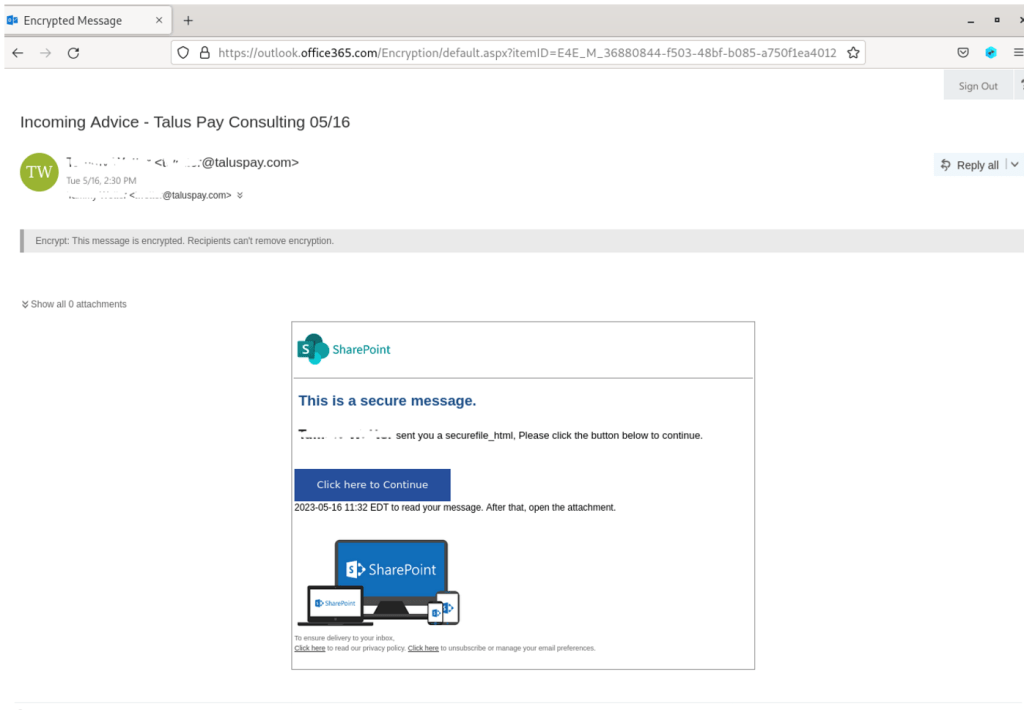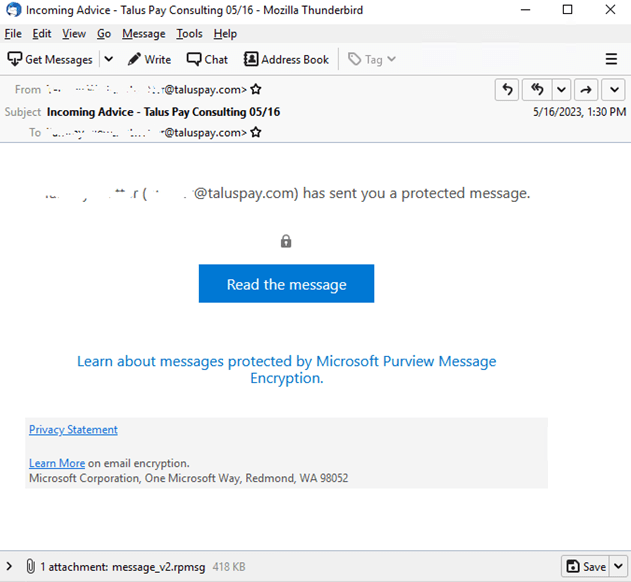Experts warn of phishing attacks that are combining the use of compromised Microsoft 365 accounts and .rpmsg encrypted emails.
Trustwave researchers have observed threat actors using encrypted RPMSG attachments sent via compromised Microsoft 365 accounts in a phishing campaign aimed at stealing Microsoft credentials.
RPMSG files are used to deliver e-mails with Rights-Managed Email Object Protocol enabled. This protocol controls e-mail access and usage permissions. Instead of a plain text, e-mails via RPMSG files are sent with content encrypted and stored as encrypted file attachment.
The recipients can read the encrypted messages only after being authenticated with their Microsoft account or obtaining a one-time passcode.
The attacks analyzed by Trustwave commenced with a phishing message originating from a compromised Microsoft 365 account, in this case from the payments processing company Talus Pay.
“The recipients were users in the billing department of the recipient company. The message shows a Microsoft encrypted message. In the email, the From: and To: email address displayed in the header were the same, but the message was delivered to various third party recipients.” reads the report published by Trustwave.
The message attempts to trick recipients into clicking the “Read the message” button to decrypt the protected message. Upon clicking the link, the recipients are redirected to an Office 365 webpage with a request to sign into their Microsoft account.
Once authenticated with the Microsoft service, the recipients are redirected to a page displaying the attackers’ phishing email. The message contains a “Click here to Continue” button that points to a fake SharePoint document hosted on Adobe’s InDesign service.

If the recipient clicks on “Click Here to View Document” on the Adobe document, he will be redirected to the final page, which resembles the domain of the original sender, Talus Pay. However, this landing page has a .us TLD and was registered recently on May 16, 2023.
?The page only displays a “Loading…Wait” message in the title bar, while in the background it relies on a Javascript that collects system information.
The script uses the open source FingerprintJS library to collect recipient’s data, including visitor ID, connect token (hardcoded from the configuration), connect hash (hardcoded from the configuration), video card renderer information, system language, device memory, hardware concurrency (# of processor), browser plugins installed, browser window size, orientation, and screen resolution, and OS architecture.
Once the script has completed the collection data, the page will show a fake cloned Microsoft 365 login form. Once the recipient has provided its credentials, they will be sent to a remote server under the control of the attackers.
“These phishing attacks are challenging to counter. They are low volume, targeted, and use trusted cloud services to send emails and host content (Microsoft and Adobe). The initial emails are sent from compromised Microsoft 365 accounts and appear to be targeted towards recipient addresses where the sender might be familiar.” concludes the report. “The use of encrypted .rpmsg messages means that the phishing content of the message, including the URL links, are hidden from email scanning gateways. The only URL link in the body of the message points to a Microsoft Encryption service.”
Follow me on Twitter: @securityaffairs and Facebook and Mastodon
(SecurityAffairs – hacking, RPMSG files)
The post Attackers use encrypted RPMSG messages in Microsoft 365 targeted phishing attacks appeared first on Security Affairs.


